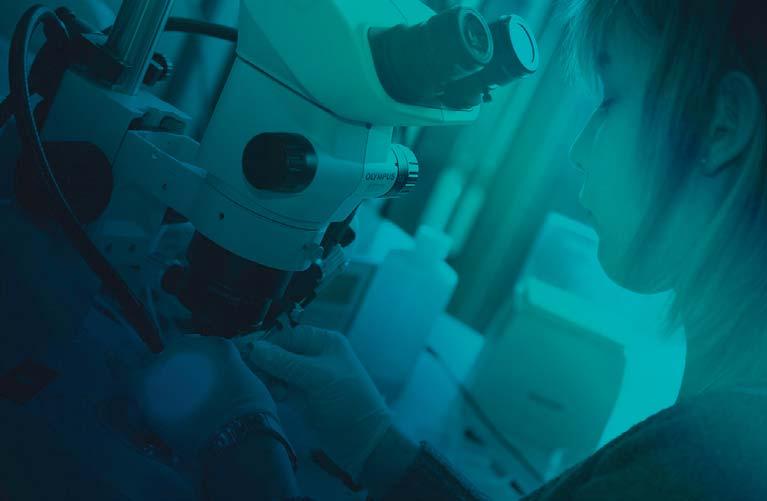n o v a t
B
i o
© LTAP - UCLouvain
n
strategies are comparatively applied to samples razilian of origin, Teresinha Leal defended collected from healthy subjects and from patients a PhD thesis in 1989 at the UCLouvain Uniwith CF. versity in cell physiology of transepithelial ion transport under the supervision of Prof. Jean The Bubble test project is conducted in collaboCrabbé. Two years after her involvement in Cliration with the CF centre of KULeuven, the dutchnical Biology at Cliniques Universitaires St-Luc, speaking sister university of UCLouvain, and it she published a paper in Clinical Chemistry on benefits from the scientific advice of Prof. Jeffrey Pharmonitor, an aminoglycoside dosage modelling Wine from the University of Stanford, California, database software developed to ensure data US. During the test, sweat secretion, a watery traceability and to improve data archiving quality. solution, is imaged as droplets of sweat, “bubbles”, She then devoted herself to the sweat test, the formed at the surface of the skin underneath a cornerstone of CF diagnosis: she redefined the layer of oil using a camera with a macro lens test’s quality criteria and gave it a scientific dimencoupled to a computer. The originally described sion for data interpretation and criteria of test test includes multiple intradermal injections to standardization. She developed the nasal potenTeresinha Leal stimulate cholinergic (phase C) or ȋ-adrenergic tial difference, a new diagnostic test for which she (phase B) sweat secretion. The ratio of sweat has become a worldwide reference in patients as secretion rates obtained during B/C phases, its most sensitive in mice. Recognised as a qualified operator of both tests by the parameter, is almost null in CF. During the CFTR-dependent American CF Foundation and/or by the European CF Society, ȋ-adrenergic B phase, bubbles from patients with CF are reduced she has enabled the CF Reference Centre of Cliniques Universiin number and they do not grow over time in contrast to healthy taires St-Luc to participate in sponsored international clinical controls. A major advantage of the test is that it is able to better trials (Actelion, PTC, Vertex) in the search for a curative treatment define diagnosis, prognosis and efficacy of CFTR-directed therafor the disease. She has created her own research laboratory pies. However, it requires labor-intensive, operator-dependent with a multidisciplinary team and built an inter-university network, multistep image analysis, a severe limitation on its spreading giving her research a wide international visibility. Recognised among CF centers. The main goal of the bubble test project is to by the Belgian Research Foundation FNRS (clinical researcher develop a non-invasive needleless version of the test consisting in 2010-12), she has published around one hundred research artidelivering the multiple drugs required for sweat stimulation by cles in the best international journals of clinical and experimental iontophoresis or by electroosmosis, a variant of iontophoresis, pneumology. instead of intradermal injections. Moreover, the project aims at evaluating the efficacy of the automated analysis of serial bubble The MucoSweatOmics project, funded by the FNRS, is conducted images recorded during the test. In collaboration with an IT spein collaboration with Dr. Gabriel Mazzucchelli from the Laboracialist of the University of Goettingen, the AutoBuSTeD software tory of Mass Spectrometry of the University of Liège. In this has been developed to circumvent the limitations of the manual study, multi-(proteo, peptido and metabolo)-omic analyses of image analysis. sweat and sweat glands are characterized and their dynamic functional interactomes are drawn. Moreover, after MALDI imaging Both projects are in the prospect of personalized medicine (over mass spectrometry (MALDI-IMS) and profiling, laser microdis2,000 CFTR putative mutations identified) with the hope to offer section is carried out in the different portions of the sweat gland an individual-based treatment to each patient with CF. obtained from punch biopsy of the skin of a forearm. The OMICS
n
Over the past twenty years, the group of Teresinha Leal (Louvain Centre for Toxicology and Applied Pharmacology LTAP) has been working on Cystic Fibrosis (CF), the most common lethal genetic disease in Caucasian populations affecting multiple organs and systems. The group is currently involved in two clinical projects aiming at identifying new non-invasive biomarkers of CF Transmembrane conductance Regulator (CFTR) in sweat and in eccrine sweat glands to allow evaluating the efficacy of novel CFTR-directed strategies.
I
Teresinha Leal’s research on the identification of biomarkers in the sweat gland to evaluate the efficacy of treatments of Cystic Fibrosis
T e c h n o l o g y
Louvain Centre for Toxicology and Applied Pharmacology Avenue E. Mounier 53 - 1200 Brussels - Belgium Tel.: +32 (0)2 764 94 73 - E-mail: teresinha.leal@uclouvain.be - https://uclouvain.be/fr/instituts-recherche/irec/ltap 89

















































































































